| RAILROADS I was just as
interested in railroads as airplanes as a boy. My father would take my
twin brother and I to the L&N yards in Louisville, KY at least once a month.
One time when we were about 8 or 9 we rode in a 0-8-0 switcher that was
spotting cars in industrial leads near the water works in Louisville.
But somehow, college and the Air Force set my career path for many years.
When the chance to real railroading I took the leap.
First was the experience of exploring an real steam
locomotive in 2003. Click here
to see that story! |
Return to the main
page
| WORKING ON THE RAILROAD or my short lived
adventure of a lifetime. In January 2004, I was laid off after nineteen
years in the computer industry. I spent the spring looking for work.
In June I heard that the Union Pacific Railroad in the Twin Cities was
hiring "train service" crews. So I applied and was accepted!
Train Service is the crews that run a train: the
Conductor and the Engineer. Most freight trains today run with just a
crew of two. The Engineer never leaves the cab, so the Conductor does
all the work involved with moving trains from here to there including
throwing switches, uncoupling cars and coupling cars when setting out or
picking up cars at customers sites, doing the required brake tests, setting
the hand brakes on cars set out or releasing the hand brakes on cars picked
up, stretching the slack, lacing the air hoses, and keeping all the paper work. Generally you have to be a
conductor for at least two years before becoming an engineer. While
the engineer believes he or she runs the train, the conductor is in charge
of the train.
First was a three week, six days a week, "academic"
training program. The Union Pacific program was excellent, as were the
materials. The emphasis was safety over and over again. We
learned the rules - lots of rules. It was all about a 146 page book of
rules called the GCOR or General Code of Operating Rules. There were
quizzes every other day and a final for each of the six major sections to
pass to get through the program. The studying was every bit as intense
as it was in college - I had less then five hours sleep each day just trying
to keep up with the studying.
And a number of other things like hazardous material handling.
To make a long story short, the job was great, the
work interesting and fascinating. It was not difficult nor hard. All the people I
met and worked
with at the South St. Paul Section House
with were great and very helpful. It was a great experience.
But my sixty-three year old body just could not adjust to
the schedules and I could just could not get enough rest between each work
period, even with weekends off, to 'recover' between work calls. The
eight hour work periods were not as draining but the twelve hours periods would
have put me in the hospital in a week. They were scheduled for
eight hours but always ran twelve and there was one and a half to two hours
lag time at the beginning or end of the period. I was in the house just over
nine hours and could not get into a sleep pattern that gave me satisfactory
rest. I felt I was becoming a safety issue to myself and the railroad. So I elected to withdraw from the program after six weeks.
|
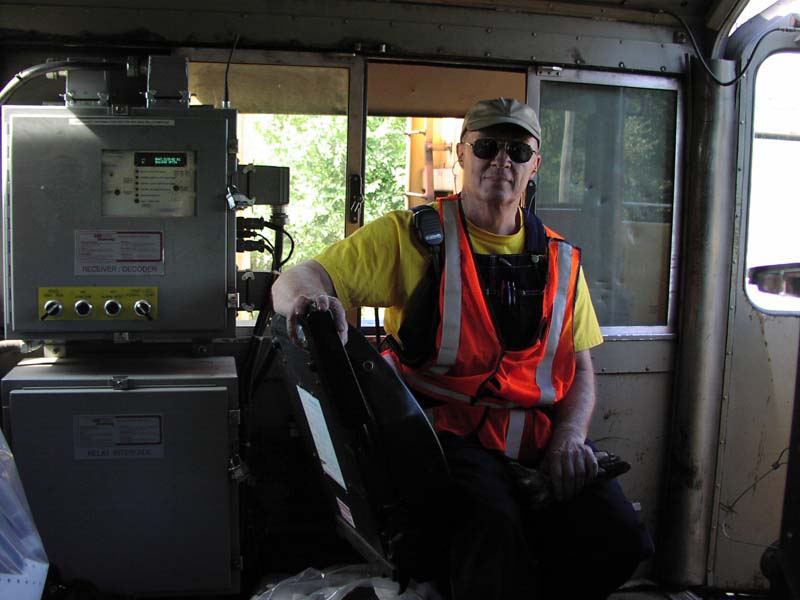 |
Here I am, waiting in a cab for another train to come through the
yard.
August 2004 I did all the things we learned in the classroom: I set hand brakes on cars and released hand brakes on cars. I
walked the train and bled the air brakes and then rode hanging on the
last car as the train was pulled forward another mile.
I lined switches in the classification yards to send cars being
"kicked" down the correct tracks to make up trains in accordance with
the switching plan put out by the yard master.
I brought the power back to a joint on a cut of cars, then
stretched the slack, called the "red zone", laced the air hoses and opened the angle cock,
and cleared for the move. I always had my “grip” with me - a large gym
bag with my lunch, rain suit, extra gloves, books of rules and
regulations, lantern, extra battery for the lantern, etc. If you
are going on the road, you may also carry a spare air hose and hose
hangers. |
First thing you have to do is get on the
engine. The first step may be 16 to 20 inches up so you always use two
hands. If you are carrying something, like the grip or a water cooler, you
toss those up on the top platform first, then climb on board.
Always use two hands - it is one of the rules and is for your safety.
|
The 16 cylinder diesel engine may already
be running - idling - imparting a light pulsating vibration to the cab
like rumm, rumm, rumm two or three times a second. The engine
is in the center of the locomotive, with the generator on the front and
the air compressor on the rear. The generator is DC - 600 volts to
drive the traction motors on the axles.
This is looking out the door on my right. Our two
engines have pulled a cut of about 70 cars as far forward on the track as
we could without "fouling" any other track, and are waiting for a train to come through, then we will take
the first 23 cars and pull them forward to start shoving and kicking
then onto the yard tracks to put them on the right tracks to make up
trains that will be leaving latter on in the day or night. After
the first 23 cars are done, we will come back against the remaining cars
and get the next 20 to 25, depending on weight and/or length, and so on
until they are all spotted. Then we will get the next big cut of
cars left from another inbound train.
|
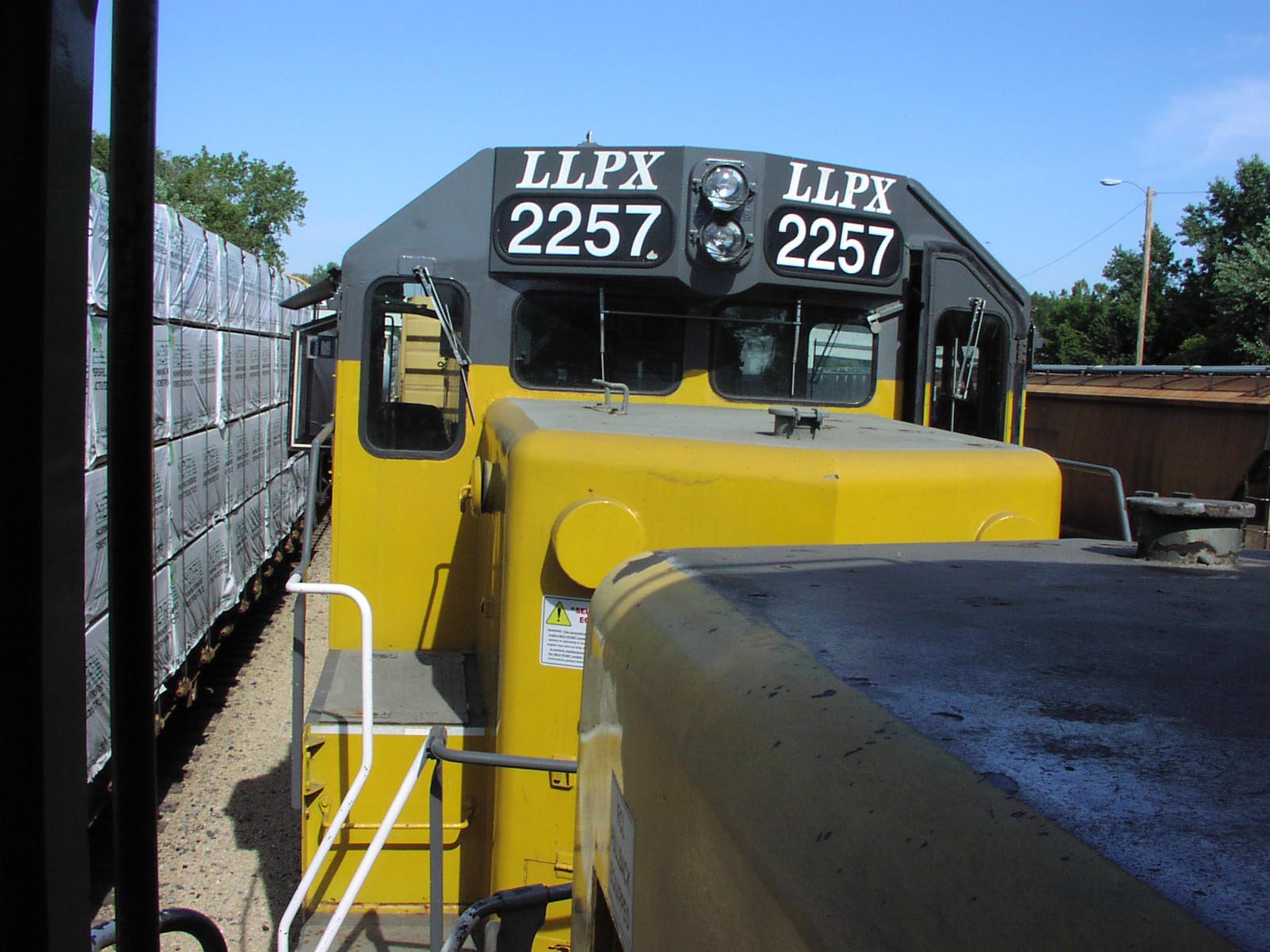 |
When you first get to the section house, you collect three things: current
track warrants, the track plan and the switching plan. The track warrants
detail any restrictions on the tracks in the area. These restrictions
might be to go slow between certain mile posts or they might detail where
maintenance crews are working in the track. The track plan shows what each
track in the yard is being used for and how many cars are on each track.
The switching plan shows what cut of cars we will work with today and where (on
which track) each and every car will go. The switch plan also shows what
is in each car and what each car weights.
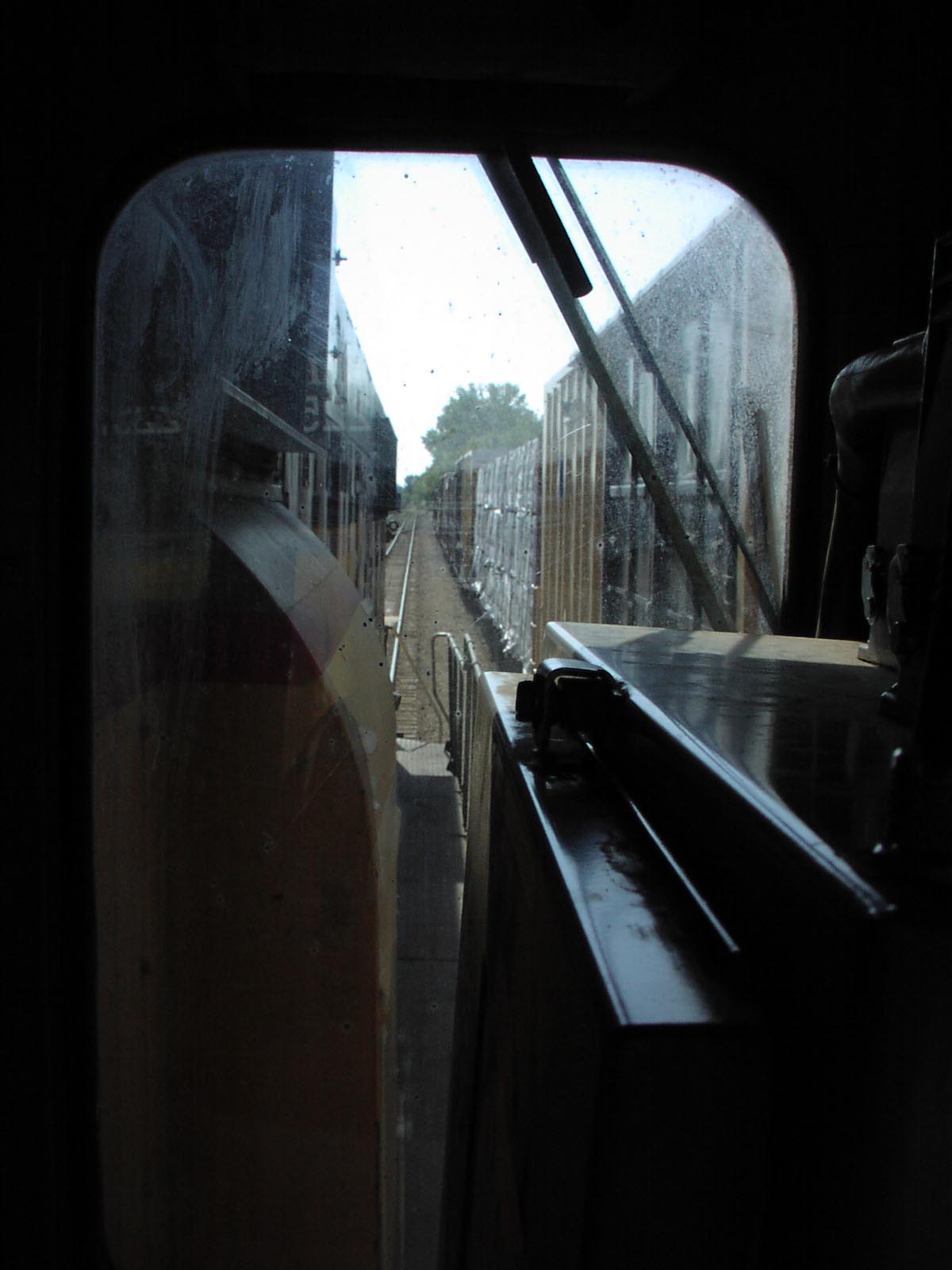 |
And this is looking out
the window on my left. The train on the right has three SD90MAC
engines on it - the biggest available, and about 114 cars. It is
waiting for the crew to take it to Iowa.
These are many rules,
which like all rules, all designed to keep you from getting injured, a
sample:
· Always expect there will be a car or engine moving at any time, on any
track in either direction.
· Never step backward (you could trip and fall, possibility bruising
yourself or falling under a moving car.)
· Never step on a rail. (you could slip and fall, or trip and fall,
possibility bruising yourself or falling under a moving car.)
· Never walk between the rails of a track and always cross tracks at
ninety degrees.
· Never get on a moving car - except for three special occasions.
· If boarding a moving car always get on the leading end and never ride
on the end, always the side, and always face the direction of movement
to watch for things that might smack you.
· When riding on cars, always hang on with that least three points - two
feet and a hand, two hands an a foot, etc.
· Always keep one foot outside the rail when lacing air hoses.
· Never cross a track within 20 feet of the end of a car
· Whenever working on the end of a car, like changing an air hose or
knuckle, always have 50 feet clear between cars.
· Only cross between coupled cars on the crossover platform and only on
cars with platforms.
· Never leave a cut of cars (or engines) without setting hand brakes
sufficient to prevent movement.
· Never “bottle the air”.
· Always anchor the air hose at the glad hand on your thigh if opening
the angle cock on a charged airline.
· When walking between tracks and a train is moving on one of the
tracks, always face the movement to watch for things that might smack
you.
etc. |
In the pictures below, of the classification yards, how do you know which
track to put which car? Every fright car has a ID or a number consisting
of the railroad abbreviation, like UP or BNSF and a unique number. For example
UP0345. Each car also had a radio frequency transponder on it call the AEI
(Automatic Equipment Inventory) device. These have been in use since 1994.
There are AEI detectors at each end of the yard leads that can "read" the ID of
the car as the train passes. This is sent to the railroads big computer
and then to the computer terminal in the yard masters office. So the yard
master can get a list of every car that has been parked on the inbound lead.
The the computer will also show details about the car, like what kind and how
long it is, etc. And the computer will also show what is in the car, where
it came from, who the shipper is and where it is to go and who should receive
the shipment. From the information, the yard master can make up a "switch
list" what shows what car or cars go on what tracks.
| This is the south end of the yard, looking south. The track on
the left is the "main track" or main line. There are
eleven tracks in
the yard with a 'ladder' or 'yard lead' on each end. The nearest
switch seen here is for track 9 and the lead continues and turns into
track 13. The two farthest tracks on the right, track 1 and 2, are
the switching leads - trains coming in from other locations tie the cars
down on these tracks. Track 3 runs from the yard all the way past
the section house and joins to the main line about a mile further south.
Track 1 joins track 2 then track 2 joins track three.
The yard master will designate tracks for making up certain trains.
For example, tracks 4 and 5 may hold the cars for a train going to
Kansas City. The terminal switching crews, using a power consist
of two engines, will move each the cars from the inbound tracks onto
each of the assigned tracks until each train is made up.
When a train is ready, the crew will pick up their power consist and
come against the cars and pick them up. In this case of the Kansas
City train, they may pick up the cars on track 5 and pull them out to
where then can shove them back onto track 4 to pick up the rest of the
assigned cars. This is called 'doubling' or "you will have to
double 5 to 4." |
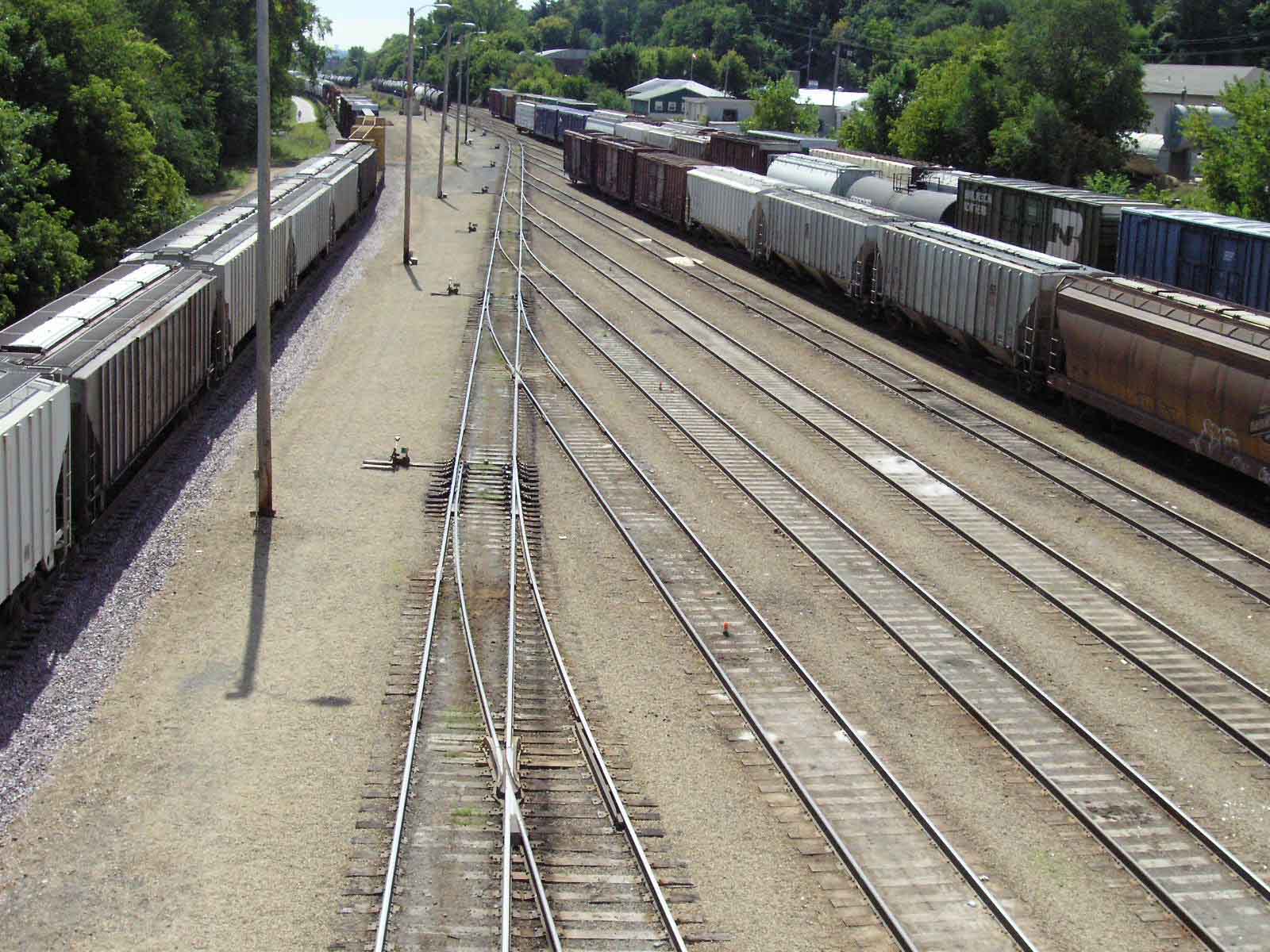 |
Once the train is all put together, the conductor will do a brake test by
walking the length of the train (which might be between 4,000 and 6,000 feet
depending on how many cars and the type of cars) and inspecting each set of
brakes of the train. First the brakes are 'set' and the conductor walks
one side of the train, the at the end of the train, he will have the
engineer release the brakes and walk the other side inspecting to see that each
brake is released. He will also verify the EOT device or End of Train
Marker is installed and working. The EOT device replaces the caboose and
is a battery powered thing attached to the last coupler and connected to the
trains air brake line. It used radio telemetry to display in the cab at
the engineers station that the trains brakes are working correctly - or not.
So there are terminal crews that do the switching making up trains, and road
crews that take the train from city to city. Some intercity trains may
roll straight through, while others may have to stop along the way at customers
locations and either set out cars or pick up cars that are ready. The cars
in any case may be 'loads' or 'empties'.
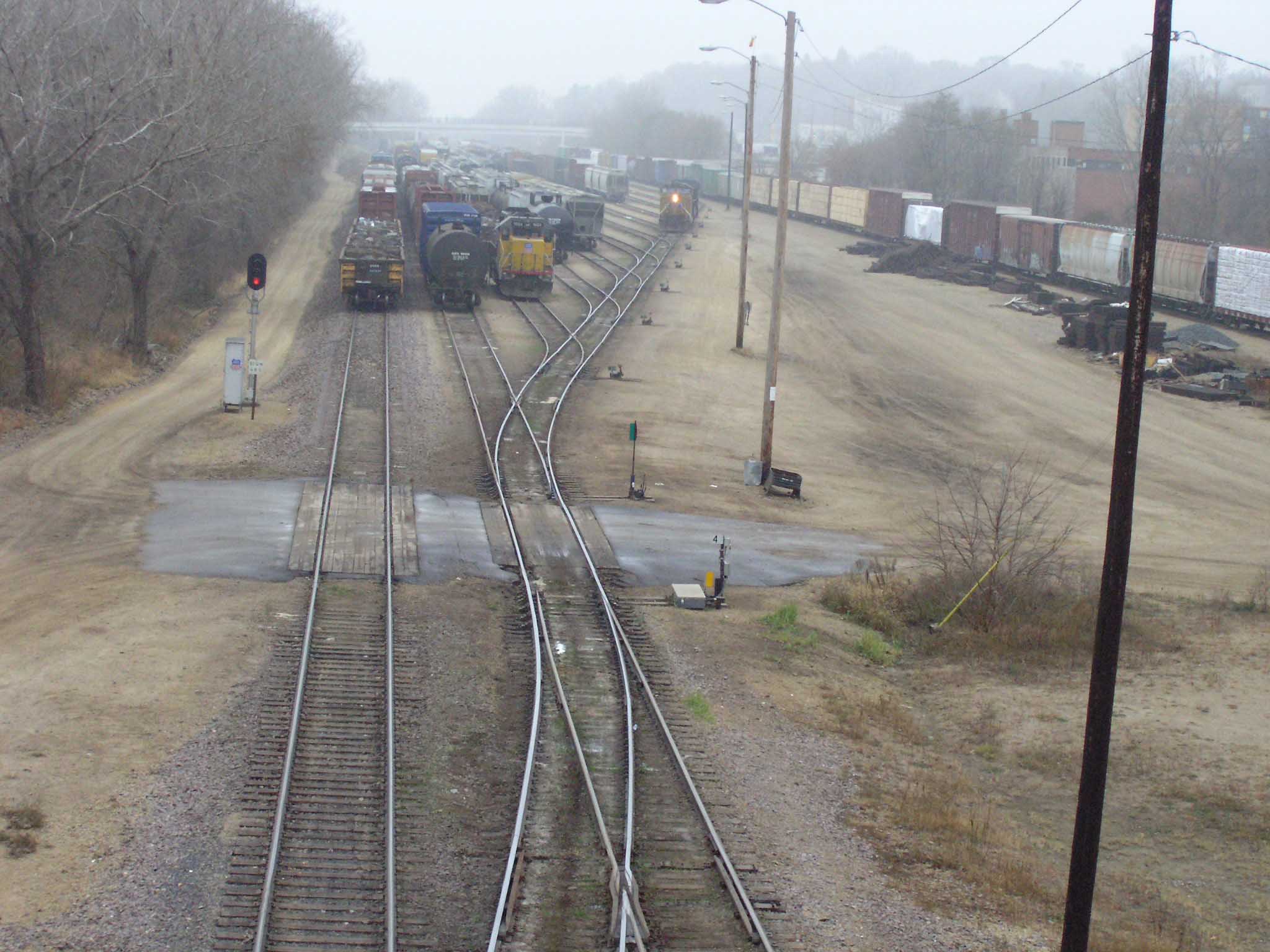 |
This is the north end of
the yard. The main track is still on the left. The long cut
of cars on the right is on track two, with track one to the right of it.
The yard track just to
the right of the main track is track thirteen of the yard. (See the
later pictures of the yard below) The yard
lead (with the engine on it with its light on) runs into track three.
One track will always be
kept clear of any cars and this track is called the "runner" to allow
thru trains to "run through the yard" if the main track is fouled or
blocked, as it is in this picture.
The "main track" is
always controlled. You must always have clearance to move or
occupy the main from the controlling railroad dispatcher. |
| This is the Minnesota Commercial "Midway" yard in
northeast Minneapolis, usually called "The Commercial". This is an "interchange" yard, where
cars and trains
from the different railroads are dropped off and remade into trains
going to other destinations.
For example, the train may come in from Glencoe MN (TCWRR) with mixed
freight. It will set the cars out on a designated track, then the
Commercial will rearrange them onto different tracks for the BNSF, etc. These railroads will come in
and pick up the cars designated for them from one or more tracks and
take them to their yards where they will be made into to trains going to
outbound cities.
The white paint marks on the rails are clearance point markers -
where no part of a car or locomotive can be beyond that point toward the
switch because that would "foul" the adjoining track and block movement
at best and cause a collision at worse. |
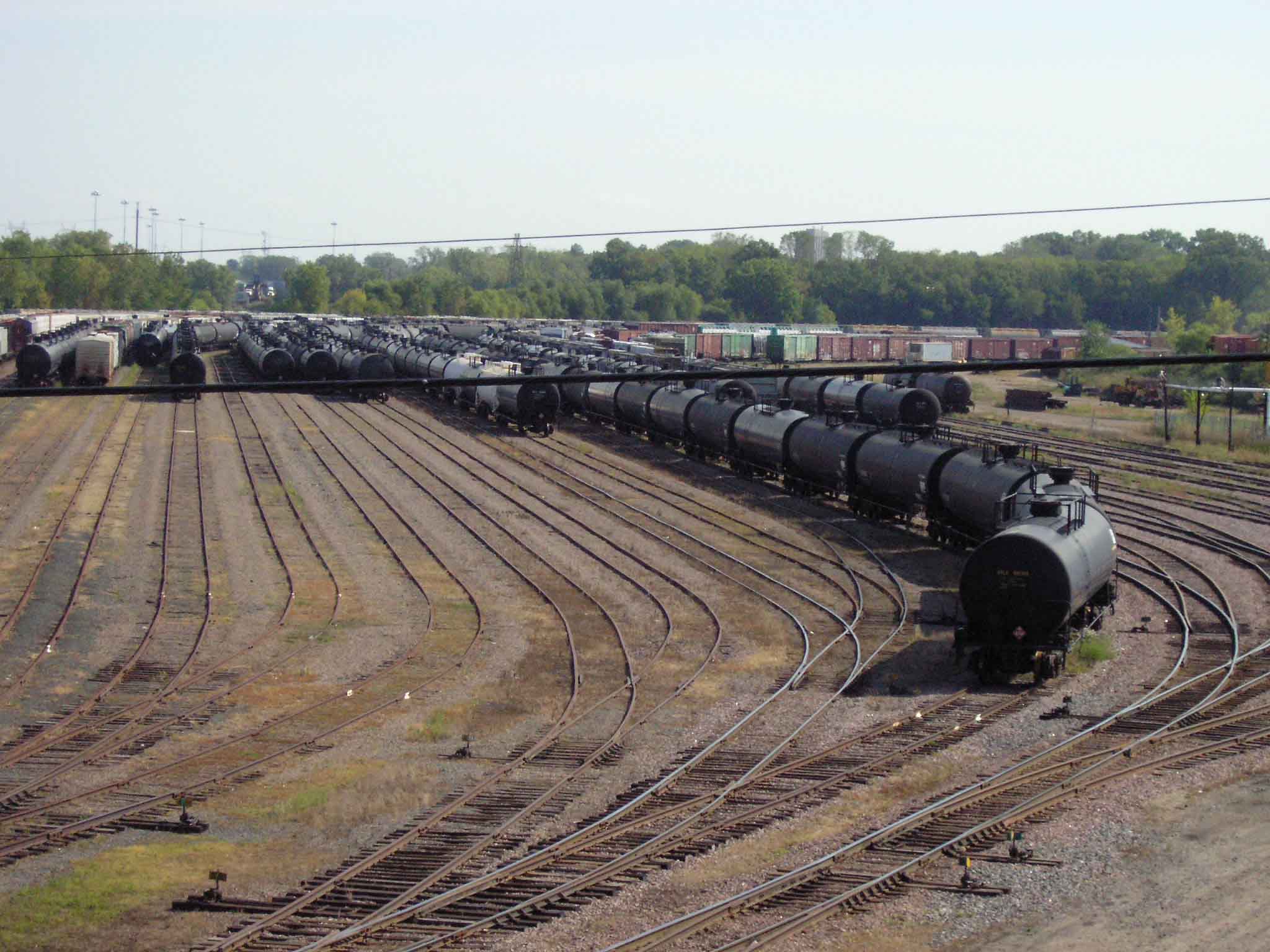 |
When I was working in this yard, it was in the dark of night and pouring rain!
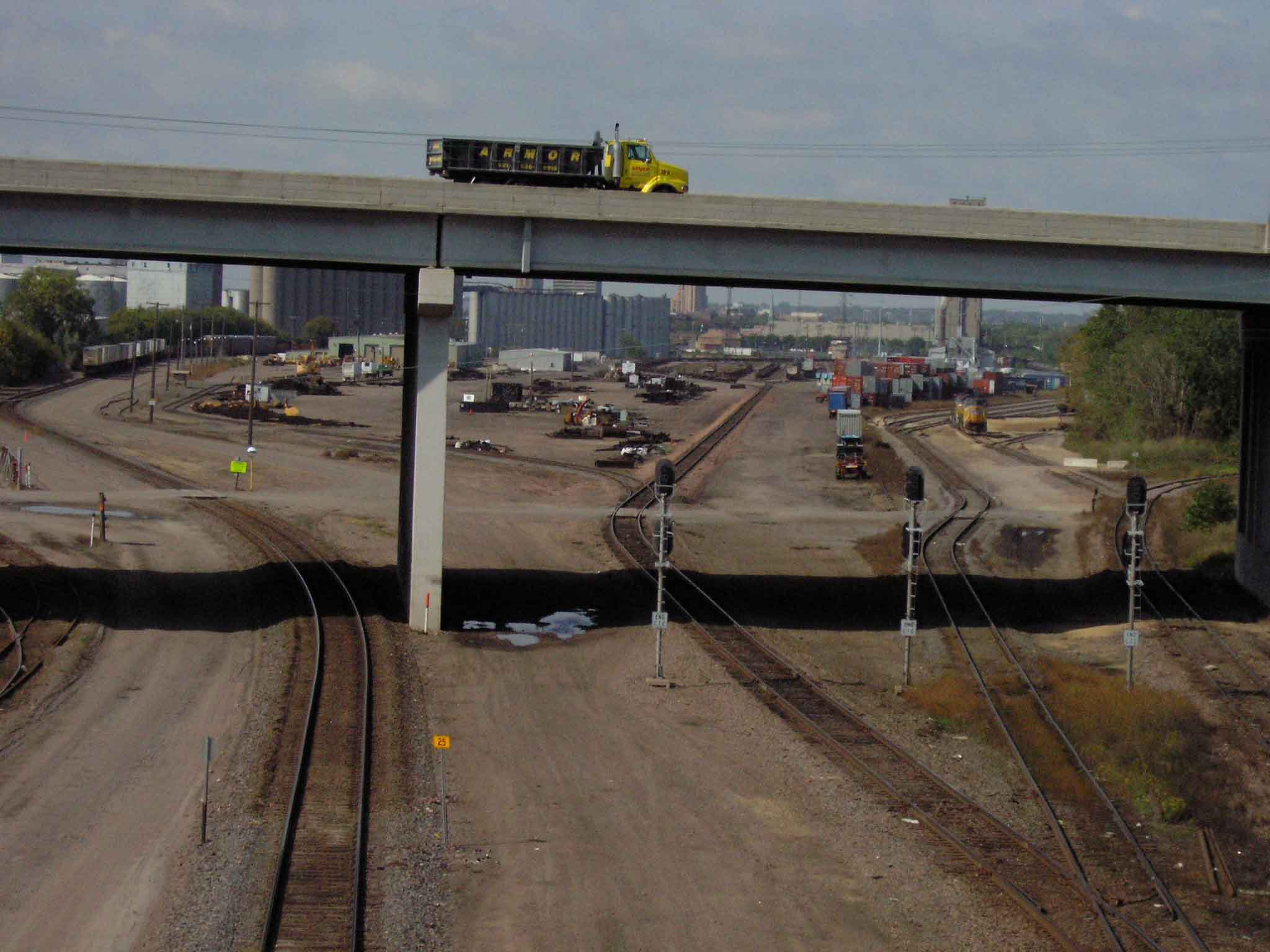 |
This is looking west from
the location of the above picture looking toward the Union Pacific 'East
Minneapolis" on the right or the BNSF 'intermodal' yard on the left.
One BNSF main track is on the far right and one on the far left.
So to get from the UP
yard to the 'Commercial' the train has to cross an interlocking of several controlled tacks
and make calls to the appropriate dispatchers for clearance to "make the
move".
Even when collecting cars
from two tracks at the "Commercial", the train may be required to pull
up and into the interlocking before it can shove back to the double, so
it may have to wait for clearance again just to do the double. The
wail may be to allow a thru train, like Amtrak, or a 'zipper' pass
through on the main track.
Once the double is made, another
clearance is required to pull across back to the UP yard, and maybe
another wait |
| This is the far east end of the UP East Minneapolis yard
on the left (with the UP locomotives and cars sitting on it) and the
BNSF intermodal yard on the right with the BNSF main track in the
middle. |
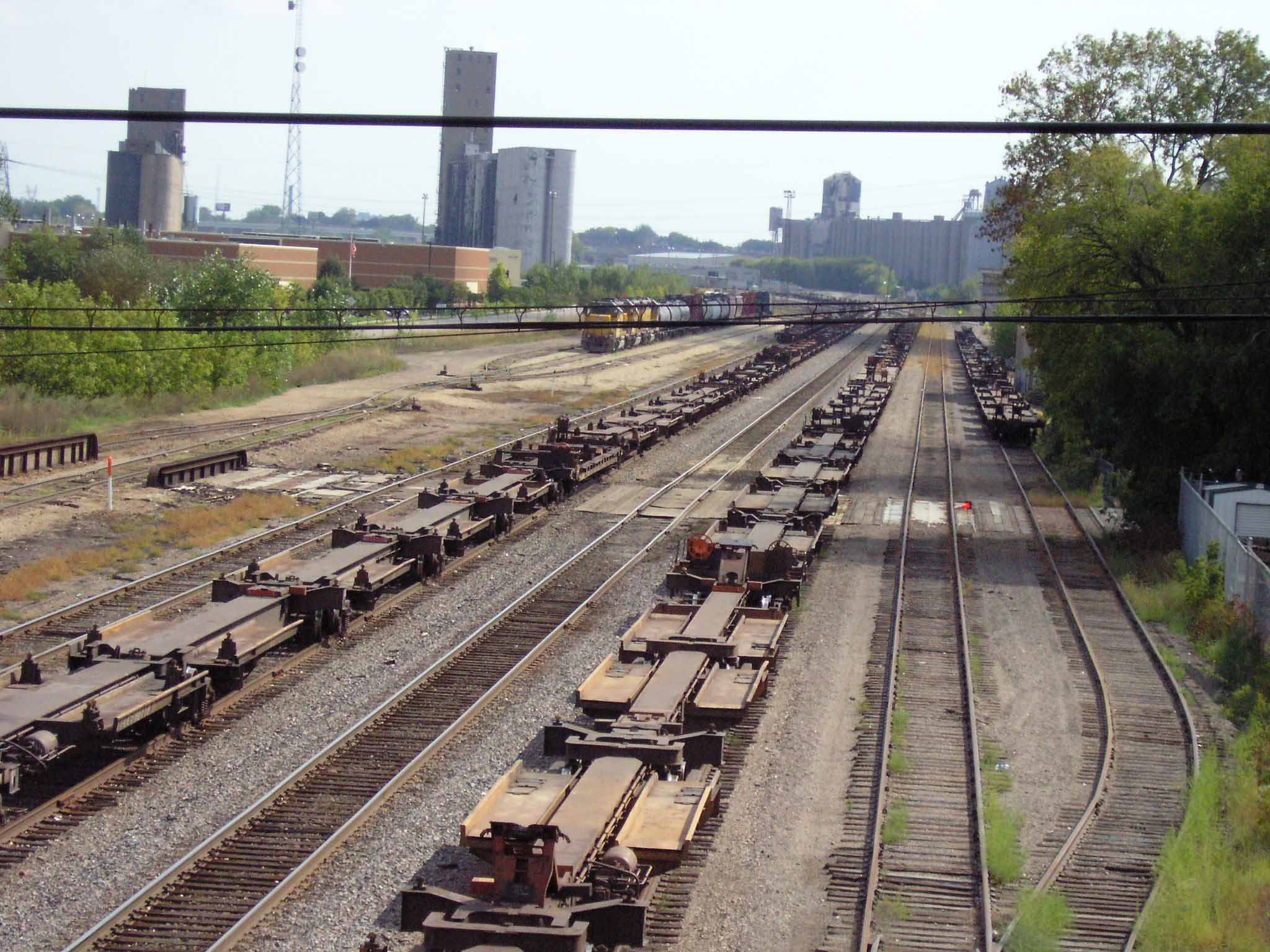 |
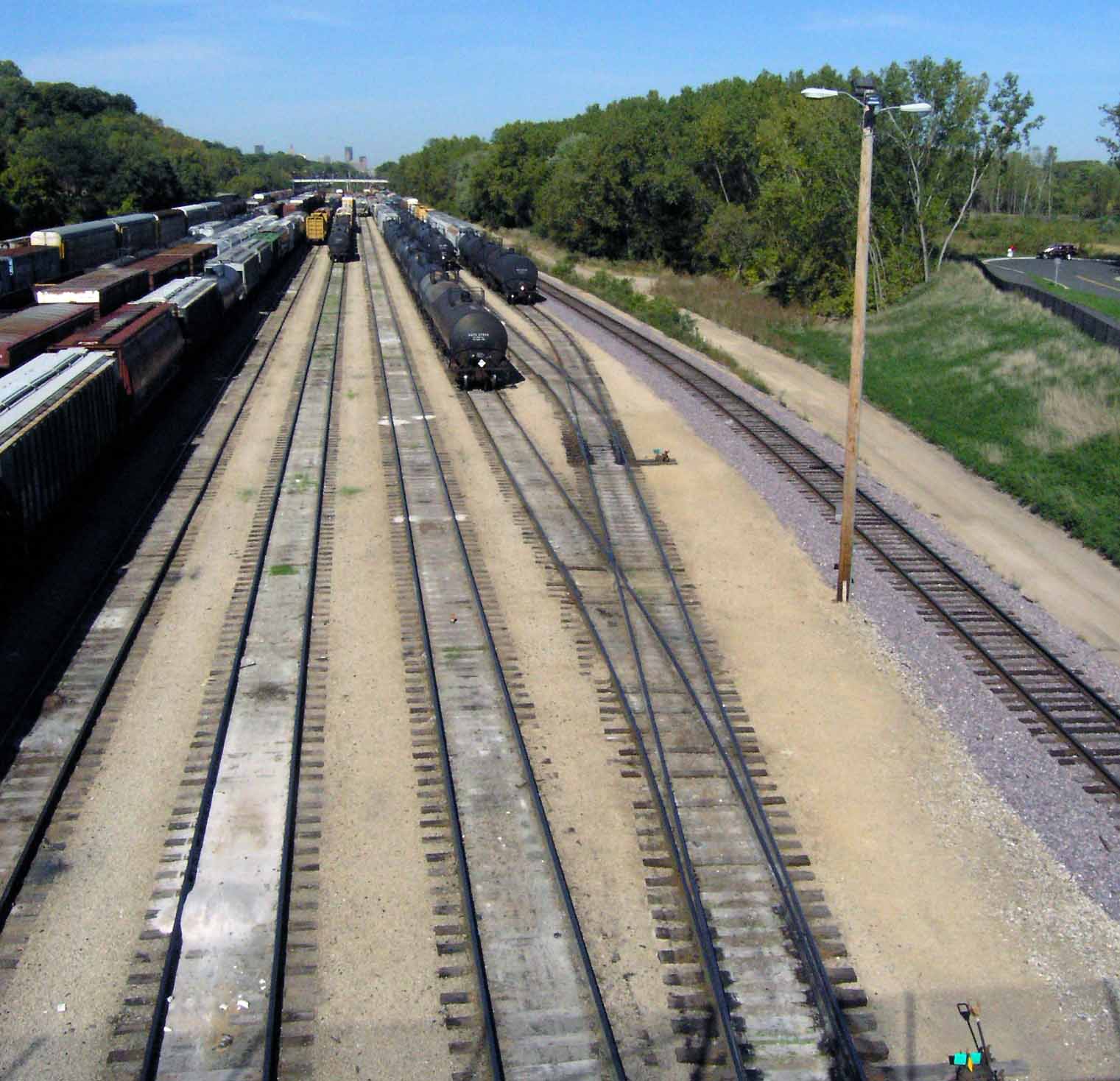 |
This is the south end of
the South St Paul yard shown above, looking north so the main track is
on the right.
The white spots on the
tracks are sand from where the engineer used sand to get better
traction. |
| This shows that the switch for track 12 is lined for
track13 - that is straight though. It it was lined for track 12 it
would be yellow. (But always verify the switch is lined as you
want, do not trust the target (the green or orange flag on the switch.
If the switch was "run through" the target may be 90 degrees off..) |
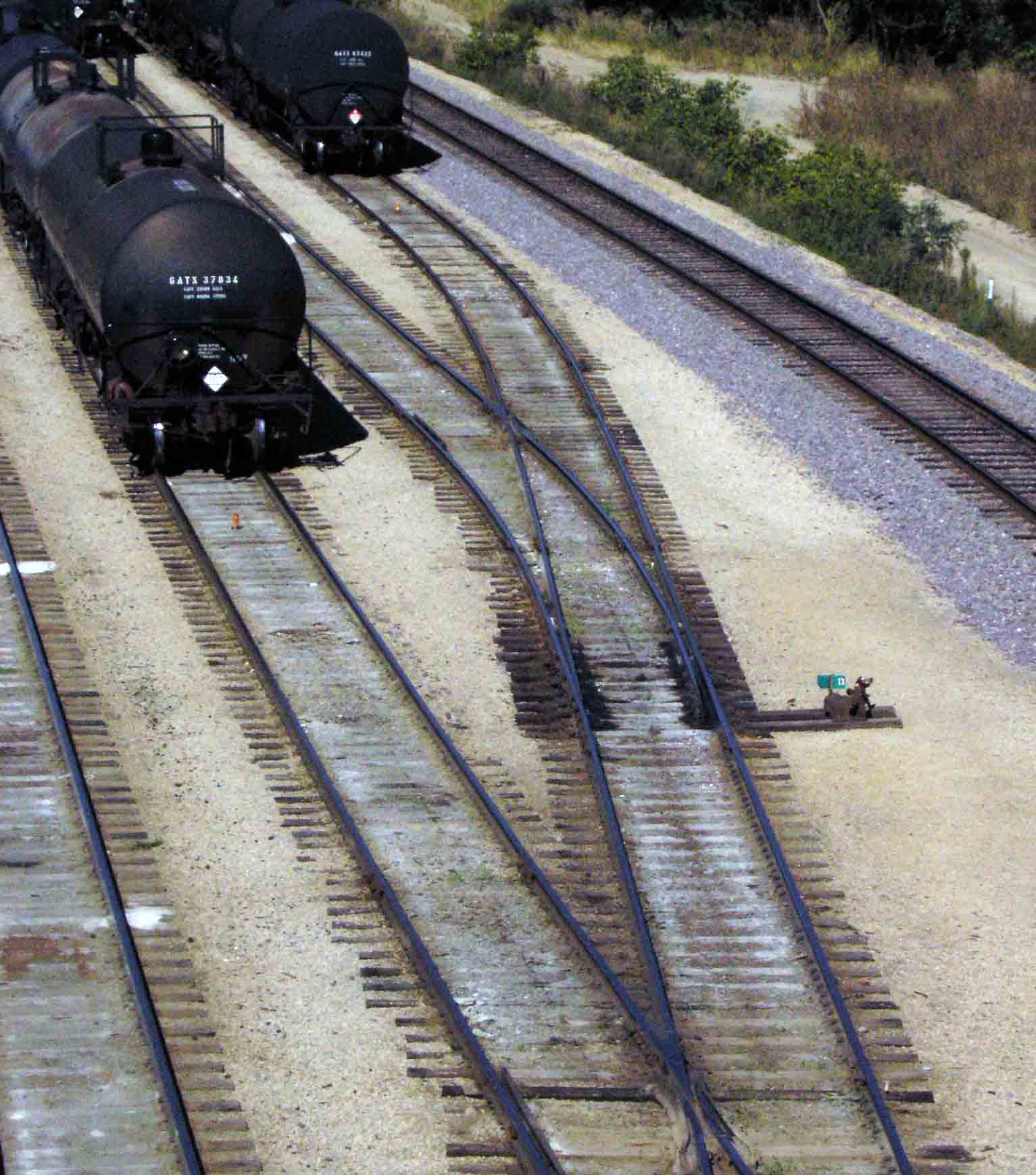 |
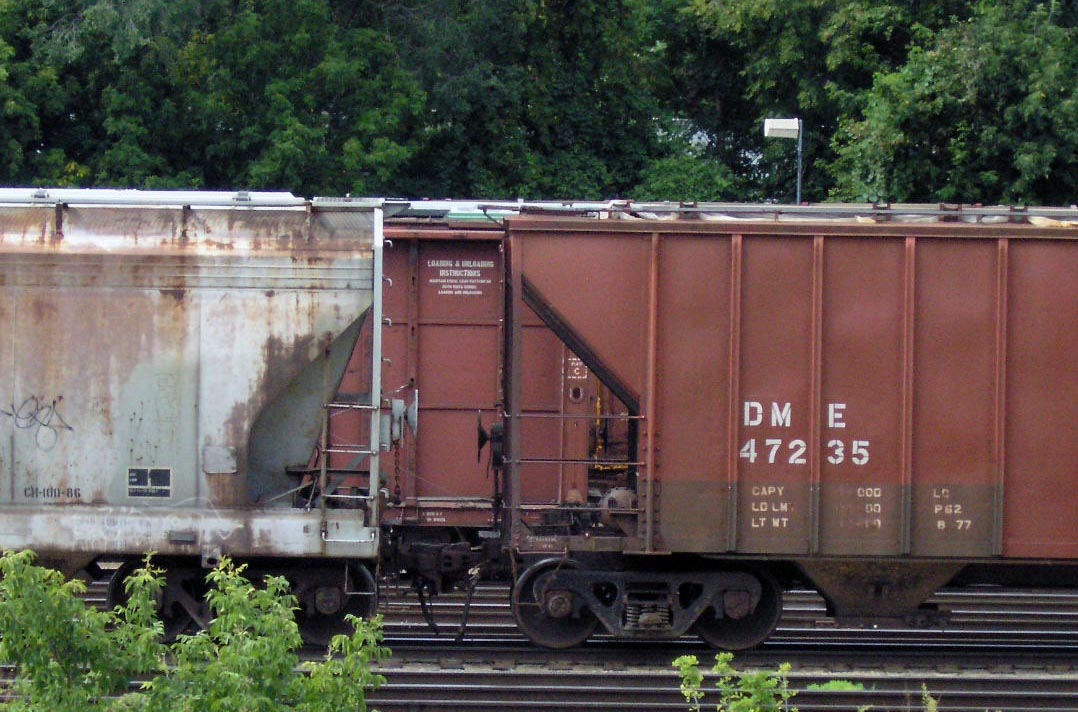
Also note the car on the
right has a 'cross-over' platform but the car on the left does not.
You can only between cars with a cross-over platform.
|
This shows two hopper
cars that are coupled, but before they are made up into a train (or a
block of cars) they will first have to be "stretched". That is a
power consist will pull the whole cut of cars forward to see if any
couplers are not locked and thus pull open. Out of 50 to 70 cars,
there may be three unlocked knuckles, but you have to fix them one at a
time. Fix and stretch again. Once all the couplers
are verified locked, the conductor will walk the length of the cut and
lace any air hoses that are found open, as they are here.
Note the car 'number':
DME47235
The small gray rectangle
on the car on the left, on the lower sill, between the two bushes, is
the AEI device mentioned earlier.
|



